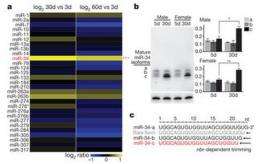February 16, 2012 report
Link found between MicroRNA and neurological aging in fruit flies

(Medical Xpress) -- Researchers from several institutions in the Philadelphia area have banded together to form a team to look into the possible impact a certain type of MicroRNA (miRNA) may have on the neurological aging process in fruit flies. They have, as they report in their paper published in Nature, found that when the miRNA, miR-34 is more active, neuron degradation due to aging is less pronounced than when it is less so or absent.
miRNA are RNA molecules with a small number of nucleotides. Their role is generally to regulate messenger RNA transcripts by binding to them.
The research by the Philadelphia team began when they found that mutations in some miRNAs tended to lead to premature neurological again and eventual deterioration, which led them to believe that some miRNAs appeared to play a role in the aging process, at least as it applied to neurons in the brain.
To find out which miRNA in particular might be playing a role in aging, the team dissected two to three hundred fruit flies that were either thirty or sixty days old. They then winnowed down the possibilities through a variety of tests and found that just one of them, miR-34, appeared to be the one responsible for the age degradation differences in the fruit flies. Specifically they found that when miR-34 was amped up, it led to a reduced expression of Eip74EF, a transcriptor believed to be involved in the degeneration of nerve cells. When it was muted or absent, the opposite occurred and those fruit flies tended to experience faster brain cell degeneration as a result.
The authors conclude that their research indicates that certain miRNA molecules appear to play a role in slowing the aging process in the brains of fruit flies by inhibiting developmental genes that may have a negative impact on neuron cells in older adults and that miR-34 appears to be one of them.
The research team did not of course attempt to replicate their efforts with humans, but suggest that because of some similarities between some components in brain structure between the two, it seems plausible that the same results might be found should another team take up the challenge.
More information: The microRNA miR-34 modulates ageing and neurodegeneration in Drosophila, Nature (2012) doi:10.1038/nature10810
Abstract
Human neurodegenerative diseases have the temporal hallmark of afflicting the elderly population. Ageing is one of the most prominent factors to influence disease onset and progression1, yet little is known about the molecular pathways that connect these processes. To understand this connection it is necessary to identify the pathways that functionally integrate ageing, chronic maintenance of the brain and modulation of neurodegenerative disease. MicroRNAs (miRNA) are emerging as critical factors in gene regulation during development; however, their role in adult-onset, age-associated processes is only beginning to be revealed. Here we report that the conserved miRNA miR-34 regulates age-associated events and long-term brain integrity in Drosophila, providing a molecular link between ageing and neurodegeneration. Fly mir-34 expression exhibits adult-onset, brain-enriched and age-modulated characteristics. Whereas mir-34 loss triggers a gene profile of accelerated brain ageing, late-onset brain degeneration and a catastrophic decline in survival, mir-34 upregulation extends median lifespan and mitigates neurodegeneration induced by human pathogenic polyglutamine disease protein. Some of the age-associated effects of miR-34 require adult-onset translational repression of Eip74EF, an essential ETS domain transcription factor involved in steroid hormone pathways. Our studies indicate that miRNA-dependent pathways may have an impact on adult-onset, age-associated events by silencing developmental genes that later have a deleterious influence on adult life cycle and disease, and highlight fly miR-34 as a key miRNA with a role in this process.
© 2011 PhysOrg.com
















